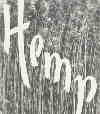
|
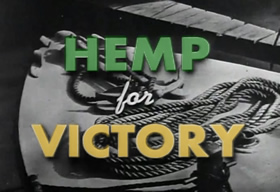 DURING THE SECOND WORLD WAR |

|
|---|
AN INDUSTRY DESTROYED

|
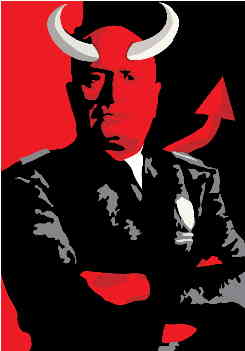 |
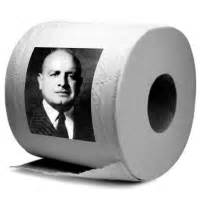
|
|---|
SATAN STRUGGLES TO RECOVER
By early 1945, two things were now certain:
- We were definitely now going to win the war
- And that we were going to do so within a short time, a year or so at most.
After all, it had been the initial uncertainty during those first dark months after Pearl Harbor and our need for vital war materials that had initially lead our nation to call upon its farmers to start re-growing Industrial Hemp. But by now we had, through military means, been able to mostly clear out the German U-Boats from the Caribbean and the whole of the Mediterranean was once again open to us. Thus the door to imported cordage materials was once more reopening to us. In addition it was not felt that at this point, we now had enough for our present and future war needs, and as soon as peace came full import capabilities would be restored. Thus there was little or no need for a subsidized war program.
However, while most federal agencies were thinking in terms of cost savings and dismantling war time governmental programs, Anslinger’s Bureau of Narcotics was probably thinking more along the lines of existence --- T H E I R S.
For the better part of a decade before the war, they had been touting the hemp plant as the “Weed of Madness.” It was a dangerous plant that made its users . . mostly blacks and Mexicans . . go out and commit incredibly hideous crimes. Yet here were tens of thousands of our farmers actively growing the stuff right in front of everyone. TRANSLATION: If this were allowed to go on it wouldn’t take long before people started putting "2 + 2" together and start to figure out that the whole thing had been one giant lie all along. Thus without a doubt Anslinger must have been very worried and if he was going to save himself he was going to have to act and act fast. Which is exactly what he did.
What follows below should be seen in context, it is but one weapon that Anslinger would use in his successful attempts to re-Kill the hemp industry yet again. --- But it was only one of many. The following newspaper article explains what happened in a nutshell.
----------In other words, Anslinger was now threatening to use the M.T.A. (Marihuana Tax Act) requiring the payment of $100 dollars per oz., just to allow a farmer the privilege of taking his hemp stalks from his fields over to the processing plant. Obviously something that could not realistically be done.
Wisconsin Rapids Daily Tribune (1945-05-05p8)
HEMP GROWERS PROTEST GOVERNMENT MEASURE
“Wisconsin hemp growers told a senate finance subcommittee Thursday the government is forcing them out of business. It seems that the leaves and flowers of the hemp plant can be used to manufacture marijuana cigarets. Recently the narcotics division of the treasury department ordered growers to remove the leaves and flowers before spending their product to the mills. Matt Rens of Brandon, Wis., told the committee that such a process not only would injure the plant but would be so costly there would be no point in growing it. “
----------
The following letter (obtained via the National Archives, College Park, Md) details some of the inner workings of what was happening behind the scenes.
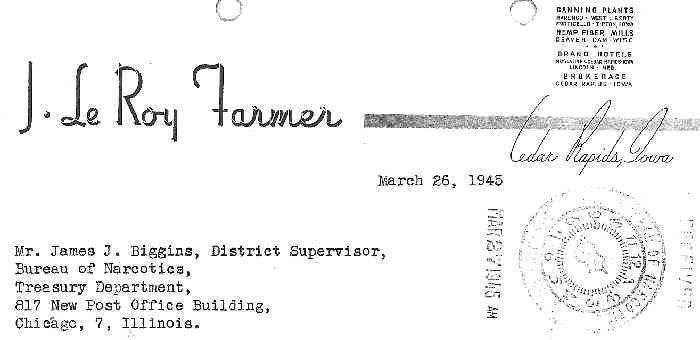
----------MODERN DAY TRANSLATION: Hey we’ve got a lot of narc’s over here looking over the whole place, what’s going on? Is something wrong?
HEMP FIBER MILLS
BEAVER DAM, WISC
J. Le Roy Farmer
March 26, 1945
Mr. James J. Biggins, District Supervisor,
Bureau of Narcotics,
Treasury Department,
817 New Post Office Building,
Chicago, 7, Illinois
Dear Mr. Biggins:
Your letter of March 23rd. addressed to J. Leroy Farmer Hemp Mill, Beaver Dam, Wisconsin has been forwarded to the writer for his attention.
In reply to your letter I wish to state that there has been no change in the method of handling hemp on the part of our growers or ourselves for several years. Why your field officers have seen fit now to make some complaint, I cannot understand.
We endeavor at all times to comply with the law and if there is anything wrong in what we are transferring from the farm to the mill we would be glad to have the field officers appear at our plant and show us what is wrong, and go into the matter somewhat in detail so that we would understand what they are talking about. I think this would be better than for them to simply send in reports to the effect that something is wrong, as we desire in every way to comply with your wishes. We want to go on record at this time as asking the complete cooperation of your department so that if there is anything wrong, we will know what it is and can correct same.
Very Truly Yours,
(signed)
J. Leroy Farmer Hemp Mill
----------
-----------------------------------------------------------------------
----------MODERN DAY TRANSLATION: Hey, what’s wrong with you guy's? We’ve been operating this way throughout the war without any trouble. Now you clowns are saying that we’ve got to start taking extra steps that (economically speaking) simply can’t be done.Sir: -
Hooker & Wagner
Attorneys & Counselors
Waupun, Wisconsin
April 6, 1945
Bureau of Narcotics,
Treasury Department,
817 New Post Office Bldg.,
Chicago, 7, Ill.
Atten - Mr. James J. Biggins,
District Supervisor.
Your letter of March 23rd addressed to the Matt Rens Hemp Company of Brandon, Wisconsin, has been referred to us for acknowledgment and consideration.
The operation followed by our client is substantially as follows: The farmer raises the hemp, harvests it, ties it in bundles, shocks it and then loads it on to a vehicle for the purpose of stacking it, either on his own land, or hauling it to a field near the mill, and stacking it there. The hemp remains in the stacks until it is ready for breaking, when it is hauled to the receiving shed and fed into a drier. From the drier, it goes to the breaker and eventually the fiber is baled and the hurds are either burned up, or hauled on to the field. In the process of drying and handling, most of the leaves are left in the field. The leaves that are still on the stalk when the bundles reach the mill, drop off during the milling operation, and such leaves are all destroyed. The farmer who grows the hemp owns the hemp crop until the fiber is actually sold. The mill is given the right to make the sale. The farmer has the option to carry the insurance on the crop, and if he does not insure it, the mill can insure it from him, but he pays the premium on the insurance policy. The proceeds from the sale of the fiber are divided equally between the farmer and the mill. When the hemp is hauled to the mill, the ownership is not changed, and the grower retains his interest in the fiber until it is sold and the proceeds divided.
Is the foregoing operation considered a transfer within the definition of the law? If so, how would you suggest that the farmer handle his crop in order to have it milled? He cannot pay the tax prescribed by the law . . . . the tax is more than the value of the hemp crop.
The leaves cannot be stripped from the stalk in the field, as we know of no machine that would perform such a stripping operation, and the operation cannot be performed by manuel labor, as the necessary labor is not available, and the cost would be prohibitive.
It will be necessary to find a solution for this problem, otherwise all of the farmers will be out of the hemp business, and the government will not receive any hemp fiber, and the prosecution of the war will suffer on that account.
We cannot over-emphasize the importance of obtaining immediate clarification of the correct application of the Act to the operations before us. Unless something can be worked out so that we can comply with the laws and interpreted by you, we will have to cancel all contracts for the growers and discontinue the hemp business. This should be done at once before the crop is planted.
We are very much interested to learn what particular difficulty has arisen that now makes it necessary to change the method of handling a hemp crop.
We will appreciate hearing from you within the next few days, and anxiously await your suggestion. We shall be very glad to call on you and discuss the matter, and relate to you any facts that we have not presented to you.
Very truly yours,
(signed)
Hooker & Waner
----------
-----------------------------------------------------------------------
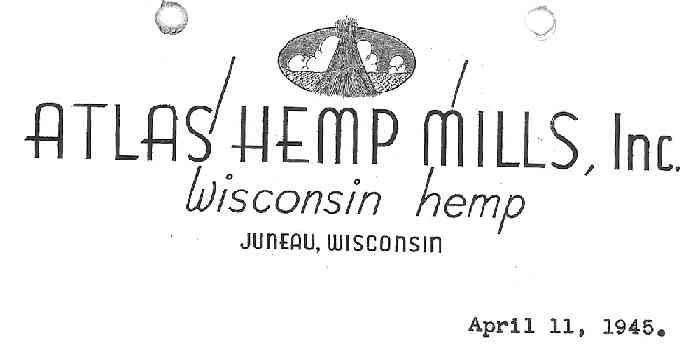
----------MODERN DAY TRANSLATION: Hey man, we need to talk this over.
ATLAS HEMP MILLS, INC.
Wisconsin hemp
Juneau, Wisconsin
April 11, 1945.
Bureau of Narcotics,
Chicago Ill.
Attention Mr. Biggins, District Supervisor.
Dear Mr. Biggins;
This will acknowledge receipt of your letter of March 23 last.
We have interviewed others involved as we are in the matter of the Marihuana Law of 1937, and it is our as well their wish to ask for a meeting with your Department some time in the future. We certainly desire to cooperate, but we have our difficulties, which we would like to air.
If this request might be granted, we assure you it will be appreciated. Very truly,
Atlas Hemp Mills
(signed O.C. Olman
----------
MEETING NOTES:
The following communication(s) were probably put together afterwards from hand written notes taken during the meeting. And they are actually quite interesting as they (focusing in on them with 20/20 hindsight), clearly shows the mind set of Harry Anslinger during this time period.
While on the surface the meetings were, as far as the Hemp farmers were concern, an attempt to reconcile some misunderstandings, it is now obvious that Anslinger himself was not interested in trying to correct any misunderstandings. His mind was made up. Hemp in whatever form had to go. Thus his sole interest in these meetings appears solely to be in finding some excuse that he can use to shut down ALL HEMP production once and for all.
----------
April 16, 1945
Memorandum for the files.
Subject: Production and transfer of hemp plants by the Matt Rens Hemp Company, Brandon, Wisconsin.
Mr. Rens of Matt Rens Hemp Company visited the Bureau of Narcotics at 3:00 p.m, April 12, 1945, to discuss the matter of the tax free transfer of harvested hemp plants from his growers to his mill at Brandon, Wisconsin, for decorticating and manufacture of hemp fiber. There were present representing the Bureau Mr. H.J. Anslinger, Mr. Will S. Wood and Mr. A.L. Tennyson.
Mr. Rens explained the production operation whereby he made a contract with each farmer-producer to grow the hemp and to subject it to field retting, after which the retted plants were moved to his mill for the extraction of the fiber. He stated that although there were some dried leaves or foliage attached to the plants when they were moved to the mill, the milling operation removed all the shriveled foliage, which was subsequently destroyed. He stated that although there were some dried leaves or foliage attached to the plants when they were moved to the mill, the milling operation removed all the shriveled foliage, which was subsequently destroyed. He explained that he had been in this business for about 30 years and had followed this same procedure, and as far as he knew there had never been any abusive use of the so-called marihuana from such plants. After he had received a communication for the District Supervisor of the Bureau prohibiting the tax free transfer of plants which had leaves or foliage adhering, he was fearful that this would be put him out of the hemp business because he did not know of any way to remove absolutely all foliage adhering to the plants. He stated that some of the leaves would be shaken off or would drop off in the course of the retting process, which included turning the harvested plants over once or twice as they lay in the field.
Mr. Anslinger explained that when the Marihuana Tax Bill was under consideration, the definition of marihuana was drafted for the purpose of endeavoring to permit the hemp industry to continue. In the exemption of “mature stalks" representatives of the Industry appeared to be satisfied with the bill and it was the understanding from representatives of the hemp industry that the foliage, including the flowering tops and leaves of the plants became entirely detached from the harvested plants during the course of the retting process. This foliage remained on the field mixed with the earth as fertilizer and there was therefore no marihuana diversion hazard involved in the subsequent tax free transfer of the bare stalks of the plant to the mill. Mr. Anslinger called Mr. Rens’ attention to Mr. Rens’ statement of on page 26 of the hearing before the Senate Finance Sub-Committee on H. R. 6906 (the Marihuana Tax Bill) on July 12, 1937. At that time Mr. Rens stated:“Now, we harvest our hemp in the State when it is still green; with no seed in it, and we field-wet it. All these leaves are gone. There is no marihuana drug there, in the way we handle it in Wisconsin, and still the grower must pay. We often have growers that only have, say two or three acres of hemp." 'Mr. Rens recalled making this statement but said he had been referring to leaves as green leaves and not in the dried up shriveled condition that the leaves would be in after the retting process. He maintained that it would be safer to have the plants transferred to the mill in the condition they were after retting, because at the mill all of the dried foliage would be removed and destroyed. It was explained to him, however, that the law did not permit transfer of the plants with full foliage as this would actually represent a transfer of marihuana as defined in the law.
Mr. Anslinger called attention to the fact that he had caused an investigation to be made of the transfer of plants to Mr. Rens’ mill in December 1939, and from a sample which Agent Cornelius Kelly had obtained and forwarded to the Bureau it appeared that all foliage had been removed from the stalks in the sample. Assuming this to be a representative sample Mr. Anslinger stated he had been satisfied that the retting process as applied by the Rens hemp project met the requirements of the law. Mr. Rens recalled that he had been present when Agent Kelly made his investigation. Mr. Rens explained that this sample or a number or stalks had been pulled from one end of a stack, which probably explained why there were no shriveled leaves on these stalks. Mr. Rens urged at some length that the requirement of complete absence of foliage from the plants when transferred would put him out of business, as he knew of no method of separating the leaves entirely from the stalks except by a manual method which would be prohibitively expensive. He stated he was in sympathy with the purpose or the Marihuana Act but he wished to stay in the hemp business and he would like to find some method which would permit him to continue in the business and comply with the law.
A discussion followed as to the extent to which foliage was actually separated from the hemp stalks during the retting process, Mr. Rens claiming that some of the leave's would drop off or be shaken off during this process. He made an estimate that perhaps 90% of the foliage might be lost in this manner, and Mr. Anslinger stated that if 90% of the normally adhering tops and leaves were separated from the stalks during the retting process in the field, he would have no objection to the tax free transfer of the hemp stalks denuded to this extent of foliage. He pointed out that an actual test made by District Supervisor Crisler showed from 50 to 150 pounds of foliage per ton of hemp stalks stored at the mill. Mr. Anslinger stated that it would be admitted that this proportion of foliage would hardly be regarded as negligible.
Mr. Ansllnger had another appointment at 4:00 p.m., at which time it was necessary that Mr. Anslinger and Mr. Wood leave the conference. Mr. Anslinger suggested that Mr. Rens could discuss the matter further with Mr. Tennyson. The only matter discussed after Mr. Anslinger's departure that had not previously been mentioned was a suggestion by Mr. Rens that he might continue the tax free transfer of the hemp plants upon a theory that he was in co-partnership with the growers, that is, that he might lease the land and have the farmers grow the hemp for him so that at all times he, Mr. Rens, would have title to the hemp and there would be no taxable transfer. Mr. Tennyson stated that it was conceivable that an agency contract might be drawn under which the physical movement of the hemp might be considered outside the scope of the "transfer" definition, but he did not consider that this would finally settle the problem because, as Mr. Anslinger had pointed out, there was a diversion hazard connected with the transfer of the marihuana material to the mill, as well as to the concentration around the mill of large quantities or this material comparatively readily available to peddlers and users of the drug. Mr. Rens stated that his idea was not to circumvent the law but that he wanted to stay in the hemp business and to have a crop planted this year, and he would like to see some method devised whereby he could continue his operations within the letter of the law and stay in business. He continued to maintain that it was not possible to separate all of the foliage from the stalks except by hand operation which was prohibitively expensive. As the hour was growing late the discussion was concluded and Mr. Rens stated he would return the next day to continue the discussion.
----------
On April 13th Mr. Matt Rens visited Mr. Tennyson at the Narcotic Bureau, accompanied by Mr. George E. Farrell of the Bureau of Agricultural Economics and Dr. B. B. Robinson of the Fiber Plant Division of the Department of Agriculture. Mr. Farrell explained that the Commodity Credit Corporation had about seventeen million dollars worth of decorticating machinery tied up in some 46 mills which had been devoted to the war emergency hemp project now about to be discontinued. He stated that studies had been made looking toward the further production of hemp (by private individuals and firms) for use in textile manufacture. He thought this an economically sound venture, and the plan had gone far enough to inquire into the possibility of establishing a spinning mill. He pointed out that hemp fiber to a large extent was used abroad in the manufacture of textiles and if the industry could be established in this country it would require the production of a much larger growth of hemp plants, and it would also provide a use for the machinery left in the possession of the commodity Credit Corporation in the war hemp project.
Mr. Tennyson explained to Mr. Farrell the Commissioner's viewpoint on enforcement of the Marihuana Tax Act, as had previously been explained to Mr. Rens. There was considerable discussion of the practicability of methods of removing the foliage from the plants in the fields but none of the visitors were able to suggest an economically practical plan. Mr. Tennyson agreed to present the new development, i.e., a government sponsored plan of increasing production of hemp for textiles, to the Commissioner for his consideration, and the visitors left with the promise to return the next day to learn Mr. Ansllnger' s reaction. It should be mentioned that Dr. Robinson reported the Department of Agriculture had caused some work to be done on breeding plants without the marihuana principle and had some success in reducing the narcotic principle, but had not succeeded in entirely eliminating this dangerous quality in the plant foliage. Both Mr. Farrell and Dr. Robinson seemed quite sympathetic with Mr. Rens' problem, and supported him in urging that the Bureau find some method whereby the hemp plants could be transferred to the mill in accordance with past procedure.
On the afternoon of April 13th Mr. Tennyson presented to Mr. Anslinger an oral summary of the morning conference. Mr. Anslinger stated the law had been passed on the representation that the hemp foliage became detached during the retting process and that he could not go further than to authorize transfer of plants from which 90% or more of the foliage had become detached. He had previously so informed Mr. Rens, and stated that the transfer of stalks in this condition would be considered substantially free of flowering tops and leaves. This ruling meant that there should be 90% of the flowering tops and leaves removed, not that the foliage remaining would be 10% by weight in comparison with the weight of the hemp stalks.
----------
On the morning of April 14th Mr. Matt Rens, Dr. Robinson and Mr. Farrell returned to the Bureau and resumed the discussion of the transfer problem. Mr. Tennyson again referred to the inspection made at Mr. Rens' plant in December 1939 by Agent Cornelius Kelly and asked Mr. Rens who took from the stock the sample of hemp stalks which had been transmitted to the Bureau for examination. Mr. Rens stated that Agent Kelly pulled out these stalks himself and that; to the best of his recollection, Agent Kelly took part of the sample from his drier. Mr. Tennyson explained to Mr. Rens that Mr. Anslinger had examined this sample very carefully and had found no foliage adhering to the stalks nor was there any foliage in the sealed package containing the stalks. This handling led to the conclusion that the retting process as pursued by the Matt Rens Hemp Company effectually removed all foliage before transfer of the plants to the mill and seemed to confirm the representations made at the time the legislative definition of "mature stalks" was drafted as part of the Marihuana Tax Act. The Commissioner concluded that if the Rens Hemp Company could accomplish this separation of the foliage, other hemp companies could do likewise. Mr. Rens stated that he felt sure there were some leaves adhering to the hemp plants transferred to the mill in 1939. He gave the explanation that the condition of the weather had much to do with the condition of the plants, and if it happened to be a dry spell when the plants were turned over in the field and when they were loaded, many more leaves would be shaken off. He also explained that while some stalks might be practically denuded of foliage others, which had undergone the same retting process, might have a quantity of dried leaves adhering.
Mr. Farrell who claimed to know something of the production of hemp plants corroborated Mr. Rens’ statements relative to the possibility of separation of foliage by retting and expressed grave doubt, as to whether the hemp plants could economically be completely denuded of foliage before the transfer. Mr. Farrell expressed the opinion that Mr. Rens and the other experienced hemp producers ought to remain in the hemp business, and that the plan of his agency and of the Commodity Credit Corporation contemplated expanded production of hemp fiber for the production of textiles. He stated that the plan contemplated a system of water retting such as was followed advantageously in Italy. In this system tanks are provided at the mill and the hemp plants are submerged in water for about 24 hours and then dried out after which the decorticating operation takes place. Mr. Tennyson asked if this plan meant that the hemp plants would be transferred to the mill practically as harvested, without field retting and therefore with the full foliage of the plant adhering to the stalk in each case. Mr. Farrell stated that this was correct. It was explained that this system would be in direct conflict with the Marihuana Tax Act, because practically all of the dangerous resin-containing material would be transferred with the stalks as compared with 'the field retting process where, it was admitted, at least some of the foliage became separated and remained in the field.
Mr. Rens was very much perturbed and asked Mr. Tennyson flatly whether he should cause hemp to be planted and to have a crop grown this year as the planting time was practically upon him. Mr. Tennyson explained that the Bureau could not undertake to approve or disapprove his planting of hemp; that the Bureau did not seek to interpose undue interference with the industry; that it had been given to understand that the Marihuana Tax Act, when drafted, provided for the continuation of the hemp industry under the description of its method of operation at that time; that this Bureau, under the law, was interested in preventing the tax free transfer of marihuana and it was the duty of the Bureau to see that the hemp plants transferred were substantially free of foliage in order to be entitled to tax free transfer. Mr. Rens was joined by Dr. Robinson and Mr. Farrell in urging that there could not be a complete separation of foliage by any field retting process. Mr. Tennyson called Mr Rens' attention to Mr. Anslinger's announcement that if in accordance with, Mr. Rens' then expressed opinion, some 90% of the foliage was removed by retting, he, Mr. Anslinger, would regard the remaining hemp stalks to be transferable as mature stalks substantially free of foliage. Mr. Rens was asked why it was not possible to conduct the retting operation in such manner as to bring the subsequent transfer within the letter of Mr. Anslinger's ruling. Mr. Rena stated he had been thinking this over, and he was apprehensive that the retting process might not remove 90% of the leaves, as a great deal depended on the weather and if the weather were not propitious he might find that more than 10% of the leaves remained on the plant notwithstanding the most careful efforts to handle the harvested crop in such a way as to try to shake oft the majority of the foliage. Mr. Tennyson explained that he felt confident Mr. Anslinger had made all concessions possible under the law and suggested that with full knowledge of the Bureau's Obligation under the law which Mr. Rens now had, he thought that with proper care in retting and possibly turning over the harvested crop two or more times, with regard to selecting the proper time within the limit at the maximum time available for retting, ought to insure compliance with the ruling. Mr. Rens then left with the understanding that he would endeavor to comply with the ruling.
----------
On April 16th Mr. Farrell called Mr. Tennyson by telephone and stated that when Mr. Rens left for Wisconsin he seemed to be still extremely apprehensive as to whether he could conform to Mr. Anslinger's position relative to separation of 90% or more of the foliage before transfer. Mr. Rens expressed a wish that he; Mr. Farrell, advise him within the next week whether he should cause a hemp crop to be planted. Mr. Tennyson in effect told Mr. Farrell that he could add nothing to what had already been communicated to Mr Rens on behalf of the Bureau of Narcotics and if this Bureau authorized him to plant a crop it could only be taken by Mr. Rens as a blanket assurance that he could transfer his retted hemp crop in the fall even though the condition of that crop did not come up to Mr. Anslinger's specifications. Mr. Tennyson explained that the Bureau could not, of course, make an administrative exemption in favor of anyone person from operation of the law. Mr. Farrell expressed the hope that the Bureau would give sympathetic consideration to Mr. Rens' problem and would permit him to harvest and transfer hemp, as much tactual information could be obtained whereby future plans could-intelligently be made.
----------
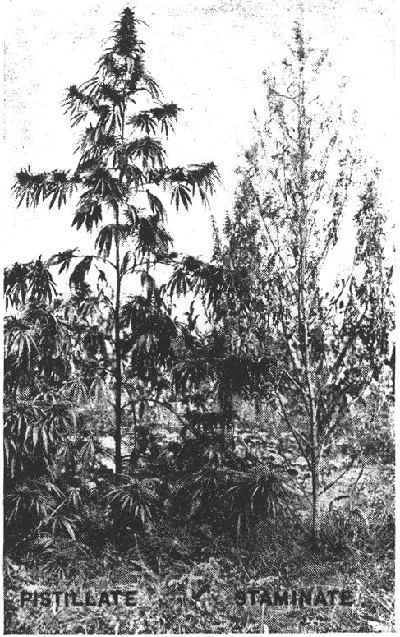
|
As this picture shows, male Hemp plant (right) begins to loose its foliage long before female (right) does. MODERN DAY TRANSLATION: - Ah Ha, we’ve got something. For our nefarious purposes, we’ll define Marihuana as any hemp plant having more than 10% of its foliage. Something guaranteed to kill the hemp industry as it is a standard that is barely possible to meet. And even if it was possible, no matter, at a later time we’ll define 10% of foliage as being some weird weight standard that will be equally impossible to meet. And in addition if we find just one plant with more than that, we’ll make the arrest. . Ha, ha, ha. .etc., . . it’s such fun to be evil . . Ha, ha, ha. Okay, granted this Modern Day Translation of what was being said by is highly opinionated, but this, from everything we’ve been able to find out about the man, was in-effect the mindset of Harry Anslinger. Simply put, he seemed to care very little about the rights of others and was determine to have his way. Thus (especially given the conditions at the time) there can be little doubt as to exactly what was going on in his mind. |
After this point, numerous internal/external communications follow. The following bits and pieces serve as examples:
----------
April 20, 1945
“It was understood from Mr. Matt Rens during his recent visit to this Bureau that the Minnesota Hemp Company did not intend to cause a hemp crop to be produced for its mill during the coming season. It was also understood that the hemp enterprise at Washington, Iowa, was not expected to continue. However, in the interest of fairness you should notify both of these mills of the new ruling.”
----------
----------MODERN DAY TRANSLATION: - We're going to put you out of business anyway, so why don't just give it up and STOP growing hemp now. You'll be doing everyone a favor including yourselves.
BUREAU OF NARCOTICS
Minneapolis 1, Minnesota.
April 23, 1945
Mr. Walter Oetjen,
Washington, Iowa
Dear Sir:
Reference is made to our previous correspondence concerning the processing of hemp at your plant in Washington, Iowa, and particularly to my to my letter of April 5, 1945, where I advised you that with respect to the 1945 and succeeding crops this bureau cannot and will not permit the tax free transfer of hemp plants from the producer to the mill unless all flowering tops and leaves are first separated from the mature stalks by retting or otherwise.
I have just received instructions to inform you that under a new ruling adopted by our Bureau if 90% of the adhering flowering tops and leaves of the plants become separated during the retting process, the plants denuded of foliage to this extent will be considered substantially free of foliage and will be transferable to the mill for decorticating without payment of the transfer tax. Very truly yours,
A.B. Crisler,
District Supervisor.
----------
----------
April 25, 1945
Mr. A. B. Crisler, district Supervisor,
Bureau of Narcotics,
Minneapolis, Minnesota.
Following is a report on the hemp leaves you delivered here March 8, 1945, which were taken from Wisconsin hemp mills:
Lab. No. Sample No. 85653 1 From Atlas Hemp Mills, Juneau, Wisconsin 85654 2 From Matt Rens Hemp co., Waupun, Wisconsin
Both samples consisted of broken hemp leaves and tops, with some occasional pieces of stalks, a few seeds, and a little foreign material. If more thoroughly broken up and sifted these samples would be indistinguishable from much of the marihuana actually sold and used in the illegal narcotics traffic. Both responded readily to the chemical tests for identification. The tests indicated a considerable degree of narcotic activity, insofar as this can be judged without any accepted specific test for the narcotic principle. Sample 1 contains the most cannabidiol, but 2 is believed to be the more active and also contains a large amount of resin. . . . more
----------
MODERN DAY TRANSLATION: - Recalling that we are talking about Industrial Hemp, not Marihuana, the only translation that we can come to today is; --- Look you stupid farmers we’ve even got fake and junk science on our side. You're going to have to STOP growing the plant period.
A HAPPY ENDING:

Seldom does any good news come out of this time period, but as this communication shows, this is one of those few cases where there appears that things, despite Anslinger’s Bureau of Narcotics wishing otherwise, ended well for the farmers.
----------
November 13, 1945
Mr. Allyn B. Crisler,
District Supervisor,
Minneapolis, Minnesota.
In re: Minnesota Hemp Co.,
Mankato, Minnesota
Dear Sir:
Reference is made to your letter of November 5, 1945, relative to an inquiry you have had from the Minnesota Hemp Company concerning an amendment to the Federal marihuana law.
You should inform the Minnesota Hemp company that Senator LeFollette of Wisconsin introduced an amendment to H.R. 2348, which would, in effect, permit the transfer of hemp from the producer to the mill without payment of a transfer tax. This amendment passed the Senate but has not been acted upon by the House of Representatives. It is understood, however, that favorable action may be expected from the House in the very near future. In view of this fact, you may advise the Minnesota Hemp Company that hemp may be transferred from the producer to the mill tax-free.
By direction of the Commissioner.
Very truly yours,
(sighed)
Will S. Wood,
Deputy Commissioner of Narcotics.
----------
MODERN DAY TRANSLATION: In this one case, it appears that the farming community had enough political pull to actually override Harry Anslinger's “personal interpretation” of what was what. But this should not be misinterpreted. As stated earlier, this was but one of Anslinger's moves to re-crush the newly revitalized war time Hemp Industry. As is obvious, he simply went about it via another route. Thus in the end it was Satan who was Triumphant.
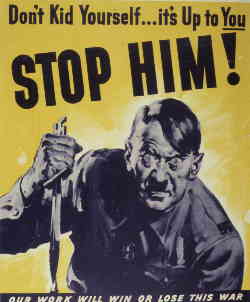
|
 |
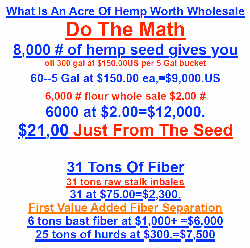
|
|---|
POSTSCRIPT [Editorial Opinion]
There are those who claim that we can just legalize Industrial Hemp without fully re-legalizing marijuana. After all, they say Industrial Hemp, with its very low THC content really isn’t Marihuana, etc. They are wrong; --- and history has proven that to be the case. Recalling that the original marihuana laws, other than in name, were never designed to prevent drug use so much as about putting/keeping black people (and/or browns) in their place. [as only blacks were using marihuana at the time, only blacks were supposed to be arrested for same]
Today the marihuana laws have become the cash cow of the whole of the “Drug Enforcement Industries”, and believe me, there are BIG BUCKS to be made there. Everything from software programs to “maximize municipalities civil asset seizers,” to fake drug rehab programs dealing with Marihuana addictions, etc., so NO-WAY do a lot of people want those laws taken off the books. And thus the reason why Industrial Hemp is never, NEVER going to reappear without first total re-legalization. Too many people are benefiting from the status quo, and they will use any excuse possible to keep things as is. A good case in point can be found here in Norman Ok, where a group of merchants (2017) were recently arrested, an arrest based solely on the “Personal Opinion” of our wonderful and ever so talented head of Narcotics over here. Did they find any drugs? NO. Did they find any drug sales? No. The arrest was based solely on the personal opinion of one man that something illegal was taking place. -- Isn’t it just amazing what interpretations a determined group of people can come up with.
Thus the reasoning why ONLY FULL relegalization will allow for restoration of the Industry. Nothing less than that will end the harassment so prevalent today.
WANT TO KNOW MORE:
=====================
Due to space / download time considerations, only selected materials are displayed. If you would like to obtain more information, feel free to contact the museum. All our material is available (at cost) on CD-Rom format.
CONTACT PAGE
 BACK TO POST WAR EVENTS |